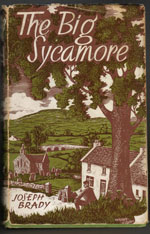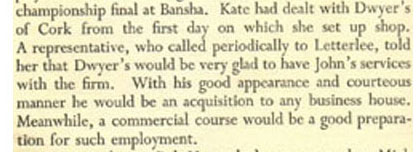
This Irish roman-a-clef of the Browne family was written in the 1950’s by Joseph Brady (nom de plume of Moss Browne) and was,I think, a bit of a best seller at that time.
It tells the story of the Browne (called FitzGerald) family, Maurice and Kate and their five children and their home in Grangemockler(Letterlee) in South Tipperary.
The whole story is, as is typical of its time, full of the healthy joys of rural Ireland at the end of the nineteenth and the beginning of the twentieth centuries. In this the characters and the descriptions of the fairs and football matches do tend to read like they were picked wholesale out of one of Canon Sheehan’s or Kickham’s novels.
There is no doubting both the politics and the religion of the biographer and he is very partisan whenever he comes up against either the English or Protestantism.
The father of the family is Maurice, he was injured as a boy in a carting accident and lost his right arm, because of this he wasn’t able to continue in the family business of cooperage in Cappoquin Co. Waterford.
Instead he became a school teacher and taught for some forty years in the little village of Letterlee.
His children obviously profited from their fathers academic leanings as four of them went on to have brilliant careers, three of the boys became priests, one Peter, (in fact a shallowly disguised portrait of Monsigneur Padraic de Brun) also a mathematician of international renown and president of UCG, another son a Cardinal of the church,and the girl, Margaret(Mary), ended up lecturing in the National University and was the mother of our own renowned poet, Maire Mac an tSaoi, whose father was Sean MacEntee, and who was wife of Conor Cruise O Brien, both very important figures in the political history of Ireland.
(it is thanks to Maire Mac an tSaoi’s excellent autobiography;The Same Age as the State that I was able to unpick the clef of the roman)
Even though the novel does tend to be a bit traditional in its depiction of the Irish peasant, it does have wonderful insights into the social history of the times. The FitzGerald family were particularly well integrated into the parish as, not only was Maurice the “Master” but Kate ran the General Store so they were the very pillars of the village.
There is also towards the end a most moving description of the events of “Bloody Sunday” in 1920 in Croke Park in Dublin, where a young footballer from their own village, wearing the Tipperary colours was shot by the Black and Tans.
But here I must declare my own interest.
As I have already written my brothers and sisters and I are beginning to compile a history of the various bits and pieces of my family in Cork.
The company of Dwyers of Cork in fact was in fact distributing goods to an area far outside Cork and indeed, from what we can gather to most of rural Ireland. This is nowhere better demonstrated than in this piece from “The Big Sycamore”.
John, the youngest and most sporty of the boys, was the only one not to enter the priesthood.
It is fascinating to see that the family then make the decision to get him employed in a firm which must, in its day, have had the necessary kudos, respectability and blue chip stability to balance the other childrens career choices:
Dwyers of Cork.
Sadly he died young after an accident on the football pitch so didnt live to take up the post.
This is how they described the job offer in the book;


Comments
The comments are closed.